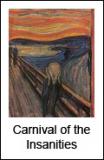The surge is on -- for the U.S. and Iraqi military. The anti-surge is on for the Washington Post. They are burying the hard news on the surge -- which happens to be favorable. Moreover, they are trumpeting a poll as front page news -- and the poll is suspect. At the end of the first week of the security crackdown, Caldwell announced, without providing statistics, a "very significant" decrease in such sectarian violence, while cautioning that it was premature to judge the plan's success. Death tolls in February provided by an official at the Baghdad morgue, who is not authorized to speak publicly, appear to support Caldwell's statement. The official said that from Feb. 1 to Feb. 13, the bodies of 806 people who died as a result of violence were brought to the morgue, including 211 unidentified bodies, many of them bound, shot and showing signs of torture. Over the next nine days, 244 bodies were brought in, among them 58 unidentified corpses. But there is still a bunker mentality among residents of the capital, who are afraid to venture out for any but the most necessary errands. The owner of a deserted fabric shop in Baghdad's Zayuna neighborhood, Manaf Ali, said his children continue to attend school only once a week because he is afraid for their lives. A goldsmith working next door at al-Faiq shopping center, Haider Mohammed, 31, sleeps on the floor of an unfurnished apartment close to his shop rather than travel to work from his embattled Sunni neighborhood of Adhamiyah. Both men carry guns. "How can we notice any change in the streets? We are just like chickens, staying in our cages," Mohammed said. "I am a goldsmith. What am I doing carrying a gun?" To Ali, 41, there are only small signs of increased order. He welcomes the presence of more soldiers on the streets, and sees fewer Shiite militiamen. "Thank God now the mass abductions and the militias seem to be slowing down, and we are only left with Along Palestine Street, a once vibrant commercial district, shop owners were relieved not by the greater military presence, but by the absence of Mahdi Army militiamen from neighboring Sadr City, the impoverished Shiite district and militia stronghold. The owner of a photography studio, a Sunni, pulled from his wallet a receipt for the "tax" that militiamen extract from merchants for their protection. Another merchant said he, too, faced extortion, which costs the equivalent of $30 a month. This month, the "savages" have not been around to collect, said the studio owner, who would not allow his name to be published. "There needs to be raids against the militias, and not only in Sadr City," said Ahmed Abdul Rahman, 29, who works in an art gallery on Palestine Street. "Until then, this is not real."
The strategy of the surge is very clear. The goal of course is to significantly improve the security situation in Baghdad. To this end, we are moving Iraqi military units, each supported by a battalion or more of U.S. combat troops, into ten areas of the city and taking up permanent positions. It is a strategy that is 180 degrees from what we've done previously, where the goal was to minimize U.S. footprint.
How the surge will work is two fold. The presence of troops within cantonment areas throughout the city will have a much higher profile, making insurgents and militias act much more circumspect. Two, it will provide much more daily interaction with citizens for both Iraqi and U.S. soldiers with the goal of earning the citizen's trust -- and it is tips from those citizens that will ultimately allow the surge to succeed in cleaning up Baghdad. Both of those things will take time to bear significant fruit, but some of the impact has been immediate and promising.
This is from the lead article today in the WP, penned by Joshua Partlow:
the suicide bombs and car bombs," he said.
Now that is the real news on the surge. For the first week of the surge, I would deem that news to be very promising. But if you read Mr. Partlow's actual article, you will not find these paragraphs until the very end, and only after a very long winded discussion of all the difficulties and negatives of both the surge and of the Iraqi units involved. In other words, this was either the author or an editor doing their best to minimize the solid news.
Lest you think me overly critical, the Washington Post front page companion piece is that of a poll of 1,000 people that they interpret as showing that the American people support, by a substantial margin, Democratic efforts "to handle Iraq." If that were true, we would already have a bill in Congress to defund the war. This poll is very suspect. The WP does not tell us the political persuasion of those polled, nor what adjustments to the poll were made. In other words, this poll has 0 credibility.
My own rule number 1 -- Polls, always subject to manipulation -- particularly those on highly charged topics -- ARE NOT NEWS. God forbid we should ever govern by polls.
What we see here is the Washington Post spinning like a top to the left side of the aisle.
Monday, February 26, 2007
WASHINGTON POST SPINNING LEFT
Posted by
scott
at
2:30 PM
![]()
Labels: Baghdad, Iraq, Partlow, poll, public opinion, spin, surge, war, Washington Post
Subscribe to:
Post Comments (Atom)



No comments:
Post a Comment